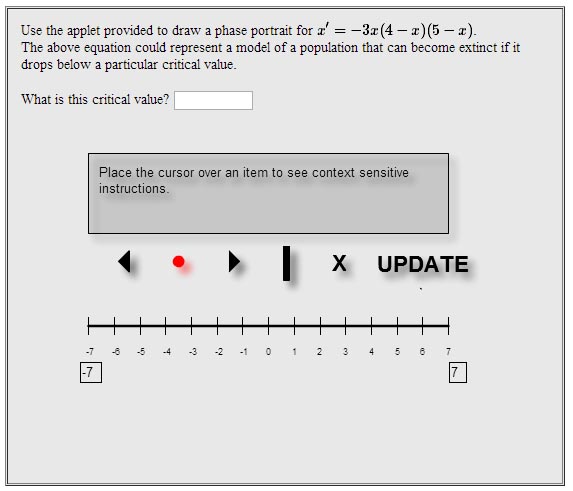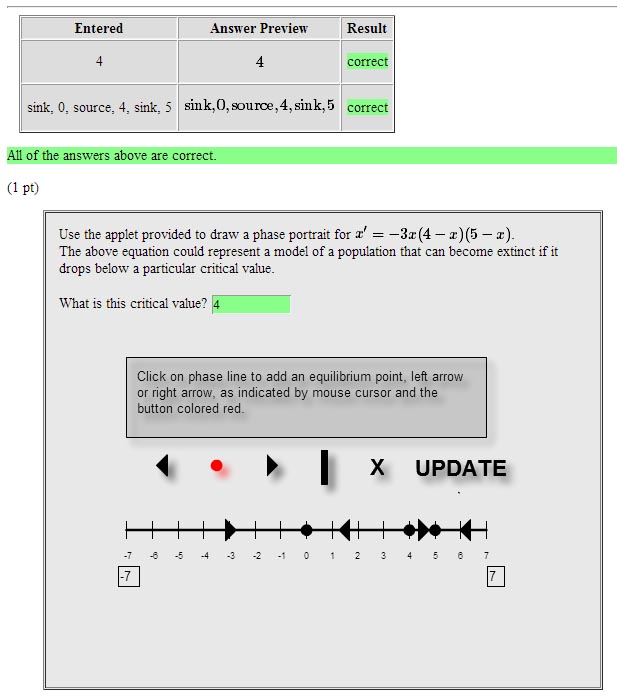PhasePortrait Flash Applet Sample Problem 1
Flash Applets embedded in WeBWorK questions phasePortrait Example
Page Under Construction
Sample Problem with phasePortrait.swf embedded
This sample problem shows how to use this versatile applet.
The images below show the applet embedded in a WeBWorK homework problem. Note that the darker gray rectangle in the middle shows context sensitive help. The second imagereflects the help shown when the mouse hovers over the phase line. The applet asks the student to draw a one-dimensional phase portrait for the given differential equation. The applet can then grade the students drawing. Drawing is accomplished by placing equilibrium points, right and left arrows, and a symbol for derivative undefined on the phase line.


A standard WeBWorK PG file with an embedded applet has six sections:
- A tagging and description section, that describes the problem for future users and authors,
- An initialization section, that loads required macros for the problem,
- A problem set-up section that sets variables specific to the problem,
- An Applet link section that inserts the applet and configures it, (this section is not present in WeBWorK problems without an embedded applet)
- A text section, that gives the text that is shown to the student, and
- An answer and solution section, that specifies how the answer(s) to the problem is(are) marked for correctness, and gives a solution that may be shown to the student after the problem set is complete.
The sample file attached to this page shows this; below the file is shown to the left, with a second column on its right that explains the different parts of the problem that are indicated above. A screenshot of the applet embedded in this WeBWorK problem is shown below:
There are other example problems using this applet:
GraphLimit Flash Applet Sample Problem 2
And other problems using applets:
Derivative Graph Matching Flash Applet Sample Problem
GraphSketch Flash Applet Sample Problem 1
USub Applet Sample Problem
trigwidget Applet Sample Problem
solidsWW Flash Applet Sample Problem 1
solidsWW Flash Applet Sample Problem 2
solidsWW Flash Applet Sample Problem 3
Hint Applet (Trigonometric Substitution) Sample Problem
Other useful links:
Flash Applets Tutorial
Things to consider in developing WeBWorK problems with embedded Flash applets
| PG problem file | Explanation |
|---|---|
## DESCRIPTION
## First order ODEs: phase portraits
## ENDDESCRIPTION
## KEYWORDS('differential equations','first order','phase portraits','Flash applets','NSF-0941388')
## DBsubject('Differential Equations')
## DBchapter('First Order Differential Equations')
## DBsection('Phase Portraits')
## Date('02/14/2013')
## Author('Barbara Margolius')
## Author('Felipe Martins')
## Institution('Cleveland State University')
## TitleText1('A Modern Introduction to Differential Equations')
## EditionText1('2009')
## AuthorText1('Ricardo')
## Section1('2.5')
## Problem1('A11')
###########################################
# This work is supported in part by
# the National Science Foundation
# under the grant DUE-0941388.
###########################################
|
This is the tagging and description section of the problem. Note that any line that begins with a "#" character is a comment for other authors who read the problem, and is not interpreted by WeBWorK. The description is provided to give a quick summary of the problem so that someone reading it later knows what it does without having to read through all of the problem code. All of the tagging information exists to allow the problem to be easily indexed. Because this is a sample problem there isn't a textbook per se, and we've used some default tagging values. There is an on-line list of current chapter and section names and a similar list of keywords. The list of keywords should be comma separated and quoted (e.g., KEYWORDS('calculus','derivatives')). |
DOCUMENT(); loadMacros( "PGstandard.pl", "MathObjects.pl", "AppletObjects.pl", ); |
This is the initialization section of the problem. The first executed line of the problem must be the
The |
TEXT(beginproblem());
#############################
# Setup
#############################
Context("Numeric");
Context()->flags->set(
tolerance => 0.1,
tolType => "absolute",
);
$a=random(1,4,1);
$b=random(1,4,1);
if($b==$a){
$b++;
}
$varLabel = "x";
$smaller = $b;
$bigger = $a;
if($a<$b){
$smaller = $a;
$bigger = $b;
}
$c=random(2,5,1);
$xmin = Compute("-$bigger-2");
$xmax = Compute("$bigger+2");
$showSolution = false;
if(time>$dueDate){
$showSolution=true;
}
$arrow1 = Compute("($xmin)/2");
$arrow2 = Compute("($smaller)/2");
$arrow3 = Compute("($smaller+$bigger)/2");
$arrow4 = Compute("($xmax+$bigger)/2");
$arrow1dir = "r";
$arrow2dir = "l";
$arrow3dir = "r";
$arrow4dir = "l";
Context()->strings->add(sink=>{},source=>{},node=>{},inc=>{},dec=>{},all=>{},usource=>{},usink=>{});
$anslist = List("sink",Compute("0"),"source",Compute("$smaller"),"sink",Compute("$bigger"));
|
The phasePortrait.swf applet ...
The applet has solution information embedded in it. When ... |
This is the Applet link section of the problem.
Those portions of the code that begin
the line with | |
###################################
# Create link to applet
###################################
$appletName = "phasePortrait";
$applet = FlashApplet(
codebase => findAppletCodebase("$appletName.swf"),
appletName => $appletName,
appletId => $appletName,
setStateAlias => 'setXML',
getStateAlias => 'getXML',
setConfigAlias => 'setConfig',
maxInitializationAttempts => 5, # number of attempts to initialize applet
answerBoxAlias => 'answerBox',
height => '400',
width => '550',
bgcolor => '#e8e8e8',
debugMode => 0,
submitActionScript =>
qq{getQE("answerBox").value=getApplet("$appletName").getAnswer() },
);
|
You must include the section that follows |
###################################
# Configure applet
###################################
$config_string = <<"ENDCONFIG";
<XML>
<leng>400</leng>
<vari>$varLabel</vari>
<xmin>$xmin</xmin>
<xmax>$xmax</xmax>
<showSolution>$showSolution</showSolution>
<solutionPts>
<aPicon lrn='$arrow1dir' loc='$arrow1'></aPicon>
<aPicon lrn='n' loc='0'></aPicon>
<aPicon lrn='$arrow2dir' loc='$arrow2'></aPicon>
<aPicon lrn='n' loc='$smaller'></aPicon>
<aPicon lrn='$arrow3dir' loc='$arrow3'></aPicon>
<aPicon lrn='n' loc='$bigger'></aPicon>
<aPicon lrn='$arrow4dir' loc='$arrow4'></aPicon>
</solutionPts>
</XML>
ENDCONFIG
$applet->configuration($config_string);
$applet->initialState($config_string);
TEXT(MODES(TeX=>"", HTML=><<'END_TEXT'));
<script>
if (navigator.appVersion.indexOf("MSIE") > 0) {
document.write("<div width='3in' align='center' style='background:yellow'>You seem to be using Internet Explorer.<br/>It is recommended that another browser be used to view this page.</div>");
}
</script>
END_TEXT
|
hi there
hi there 2 |
TEXT(MODES(TeX=>"", HTML=><<'END_TEXT'));
<script>
if (navigator.appVersion.indexOf("MSIE") > 0) {
document.write("<div width='3in'
align='center' style='background:yellow'>
You seem to be using Internet Explorer.
<br/>It is recommended that another
browser be used to view this page.</div>");
}
</script>
END_TEXT
|
The text between the |
BEGIN_TEXT
$BR
The graph shown is for the
function \(f(x)\).
$BR Compute the following
quantities:
$BR
a)
\(f($x1)=\)
\{ans_rule(35) \}
$BR
b)
\(\lim_{x\to {$x2}^+}f(x)=\)
\{ans_rule(35) \}
$BR
c)
\(\lim_{x\to {$x3}^-}f(x)=\)
\{ans_rule(35) \}
$BR
d)
\(\lim_{x\to {$x4}}f(x)=\)
\{ans_rule(35) \}
$BR
END_TEXT
Context()->normalStrings;
|
This is the text section
of the problem. The
Mathematical equations are delimited by
There are a number of variables that set
formatting: |
############################# # # Answers # ## answer evaluators ANS( $correctAnswer1->cmp() ); #checks AnSwEr00001 ANS( $correctAnswer2->cmp() ); #checks AnSwEr00002 ANS( $correctAnswer3->cmp() ); #checks AnSwEr00003 ANS(num_cmp($correctAnswer4, strings=>['DNE'])); #checks AnSwEr00004 ENDDOCUMENT(); |
This is the answer
section of the problem. The problem answer
is set by the The solution is embedded in the applet and becomes available when the due date has passed.
The |